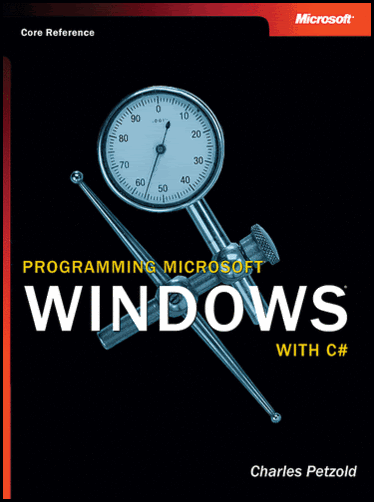 This book shows you how to write programs that run under M'zoft Windows. There are a number of ways to write such programs. In this book. I Use the new object-oriented programing language C#(pronounced "C sharp") and a moderm class library called Windows Forms. The Windows Forms class library is part of the M'zoft .NET("dot new") Framework unveriled in the summer of 2000 and intreduced about a year and a half later.
This book shows you how to write programs that run under M'zoft Windows. There are a number of ways to write such programs. In this book. I Use the new object-oriented programing language C#(pronounced "C sharp") and a moderm class library called Windows Forms. The Windows Forms class library is part of the M'zoft .NET("dot new") Framework unveriled in the summer of 2000 and intreduced about a year and a half later.The M'zoft .Net Framework is an extensive collection of classes that provides programmers with much of what they need to write internet, Web, and Windows applications. Much of the media coverage of .NET has focused on the Web programming. This book discusses the other part of .NET.You use Windows Forms to write traditional stand-alone Windows applications (what are now somietimes called client applications) or front ends for distributed applications.
Windwos Forms provides almost everything you need to write full-fledged Windows applications. The big omission is multimedia support. There's not even a Windows Forms function to beep the computer's spearker! I was tempted to write my own multimedia classed but restrained myself under the assumption (reasonalbe, I hope) that the next release of Windows Forms will include multimedia support that is flexible, powerful, and easy to use.
The classes defined in the .Net Framework are language-neutral. M'zoft has released new versions of C++ and Visual Basic that can use these classes, as well as the new programming language C#. Other language vendors are adapting their own languages to use the .NET classes. language in an .exe file. At runtime, the intermediate language is compiled into appropriate microprocessor machine code. Thus, the .NET Framework is potentially platform independent.
I chilse to use C# for this book because C# and .NET were - in a very real sense - made for each other. Because of the language-neutral aspect of the .NET Framework, you may be able to use this book to learn how to write Windows Forms applications with other .Net languages.
TABLE OF CONTENT:
Chapter 01 - Console Thyself
Chapter 02 - Hello Window Form
Chapter 03 - Essential Structures
Chapter 04 - An Exercise In Text Output
Chapter 05 - Lines, Curves And Area Fills
Chapter 06 - Tapping Into The Keyboard
Chapter 07 - Pages And Transforms
Chapter 08 - Taming The Mouse
Chapter 09 - Text And Fonts
Chapter 10 - The Times And Time
Chapter 11 - Images and Bitmaps
Chapter 12 - Buttons and Labels And Scrolls
Chapter 13 - Beziers And Other Splines
Chapter 14 - Menus
Chapter 15 - Paths, Regions And Clipping
Chapter 16 - Dialog Boxes
Chapter 17 - Brushes And Pens
Chapter 18 - Edit, List And Spin
Chapter 19 - Font Fun
Chapter 20 - Toolbars And Status Bars
Chapter 21 - Printing
Chapter 22 - Tree View And List View
Chapter 23 - Metafiles
Chapter 24 - Clip, Drag And Drop
Download This Book
Password: ganelon

No comments:
Post a Comment